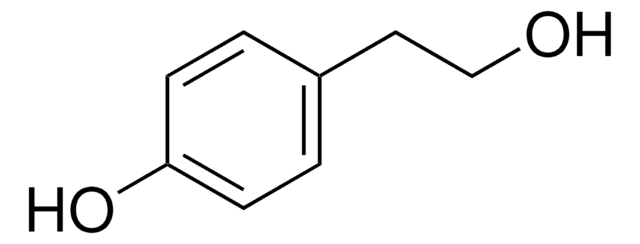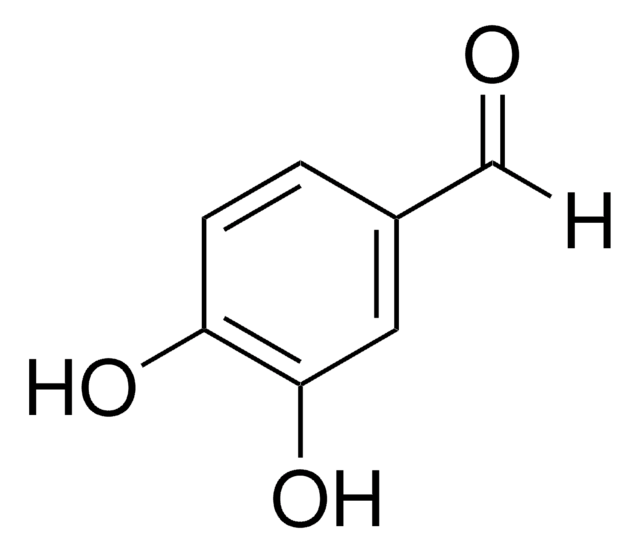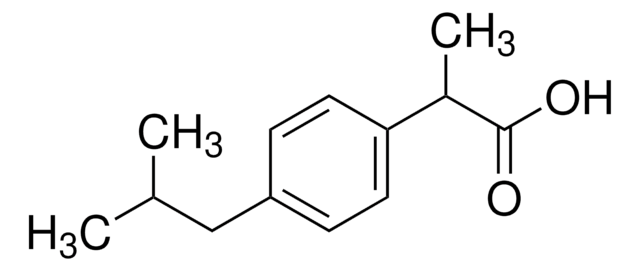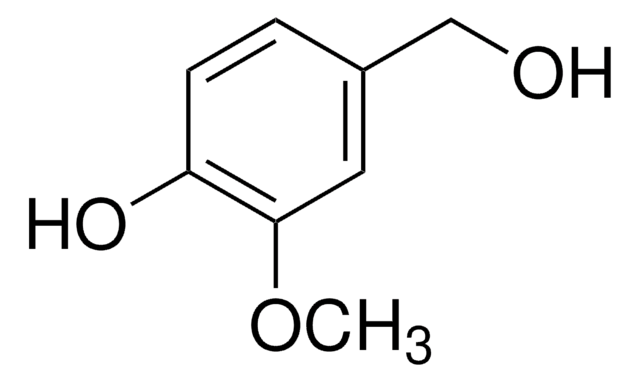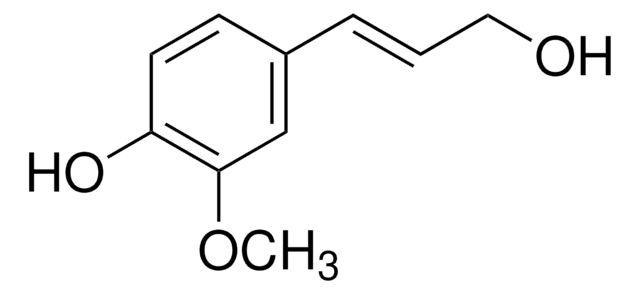Wszystkie zdjęcia(1)
Key Documents
148830
Homovanillyl alcohol
99%
Synonim(y):
4-Hydroxy-3-methoxyphenethanol, 4-Hydroxy-3-methoxyphenethyl alcohol
Zaloguj sięWyświetlanie cen organizacyjnych i kontraktowych
About This Item
Wzór liniowy:
HOC6H3(OCH3)CH2CH2OH
Numer CAS:
Masa cząsteczkowa:
168.19
Numer WE:
Numer MDL:
Kod UNSPSC:
12352100
Identyfikator substancji w PubChem:
NACRES:
NA.22
Polecane produkty
Poziom jakości
Próba
99%
Postać
solid
mp
40-42 °C (lit.)
grupa funkcyjna
hydroxyl
ciąg SMILES
COc1cc(CCO)ccc1O
InChI
1S/C9H12O3/c1-12-9-6-7(4-5-10)2-3-8(9)11/h2-3,6,10-11H,4-5H2,1H3
Klucz InChI
XHUBSJRBOQIZNI-UHFFFAOYSA-N
Opis ogólny
Homovanillyl alcohol is a key component of Queen mandibular pheromone.
Zastosowanie
Homovanillyl alcohol was used in the preparation of galactosides.
This page may contain text that has been machine translated.
Hasło ostrzegawcze
Warning
Zwroty wskazujące rodzaj zagrożenia
Zwroty wskazujące środki ostrożności
Klasyfikacja zagrożeń
Eye Irrit. 2 - Skin Irrit. 2 - STOT SE 3
Organy docelowe
Respiratory system
Kod klasy składowania
11 - Combustible Solids
Klasa zagrożenia wodnego (WGK)
WGK 3
Temperatura zapłonu (°F)
235.4 °F - closed cup
Temperatura zapłonu (°C)
113 °C - closed cup
Środki ochrony indywidualnej
dust mask type N95 (US), Eyeshields, Gloves
Wybierz jedną z najnowszych wersji:
Masz już ten produkt?
Dokumenty związane z niedawno zakupionymi produktami zostały zamieszczone w Bibliotece dokumentów.
M Phillippe et al.
American journal of obstetrics and gynecology, 143(7), 782-787 (1982-08-01)
Previous investigation has demonstrated biologically significant concentrations of catecholamines in amniotic fluid, which increase with gestation. The half life, metabolic clearance rate, and metabolic fate of these hormones in the amniotic compartment are yet to be established. This study was
K Racké et al.
Journal of neurochemistry, 46(3), 745-752 (1986-03-01)
Isolated rat neurointermediate lobes were incubated in vitro. The release of 3,4-dihydroxyphenylethylamine (dopamine, DA), dihydroxyphenylacetic acid (DOPAC), homovanillic acid (HVA), and methoxyphenylethanol (MOPET) was determined by HPLC with electrochemical detection. Under resting conditions, the outflow of metabolites was 35-50 times
D F Sharman et al.
Comparative biochemistry and physiology. C, Comparative pharmacology and toxicology, 75(2), 217-222 (1983-01-01)
Following the i.v. administration of 3,4-dihydroxyphenylethylamine (dopamine) to sheep, 3,4-dihydroxyphenylethanol and 3,4-dihydroxyphenylacetic acid rapidly appeared in the blood. 3,4-Dihydroxyphenylethanol can be formed from dopamine by blood plasma of ruminants in vitro. It is suggested that this plasma enzyme system might
Effects of L-DOPA on the excretion of alcoholic metabolites of catecholamines and trace amines in rat and human urine.
D J Edwards et al.
Biochemical medicine, 25(2), 135-148 (1981-04-01)
K Fukuhara et al.
Journal of neuroendocrinology, 8(1), 65-72 (1996-01-01)
We compared sympathoadrenal responses to intermittent cold (SART) stress (in which cold exposure is interrupted by 4-hourly intervals daily at room temperature) with those to continuous cold (-3 degrees C) stress. Plasma levels of dihydroxyphenylalanine (DOPA), catecholamines and their metabolites
Nasz zespół naukowców ma doświadczenie we wszystkich obszarach badań, w tym w naukach przyrodniczych, materiałoznawstwie, syntezie chemicznej, chromatografii, analityce i wielu innych dziedzinach.
Skontaktuj się z zespołem ds. pomocy technicznej
